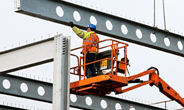Steel Markets

Nonresidential and Multifamily Construction Spending Slipped in March: AGC
Written by David Schollaert
May 5, 2022
Nonresidential and multifamily construction spending slumped in March as supply-chain woes and labor shortages stymied strong project demand, the Associated General Contractors of America (AGC) reported.
Spending on most categories of nonresidential and multifamily construction declined from February to March, AGC said, noting that contractors struggled to find enough workers and to get timely deliveries of materials.
Association leaders are again urging Washington officials to end tariffs on construction materials and increase opportunities for training in construction skills.
“Contractors continue to report strong demand for most types of structures, with few owners canceling or postponing planned projects,” AGC chief economist Ken Simonson said. “But worker shortages and supply-chain problems, from lockdowns in China to the war in Ukraine, are slowing project completions.”
Construction spending in March totaled $1.73 trillion at a seasonally adjusted annual rate, 0.1% above the upwardly revised February rate and 11.7% higher than in March 2021. Private residential construction spending accounted for all the increases, rising 1.0% for the month and 18.4% from March 2021.
In contrast, private nonresidential construction spending slumped 1.2% month-on-month (MoM), although the March total was 8.5% higher year-on-year (YoY). Public construction spending slipped 0.2% for the month but increased 1.7% YoY.
Among residential segments, single-family construction added 1.3% over the February total and 19.4% YoY. Multifamily construction fell 0.5% in March but rose 3.9% from a year earlier. Spending on improvements to existing owner-occupied houses increased 1.1% for the month and 22.5% YoY.
There were notable monthly declines in the largest private nonresidential categories despite generally robust growth from a year earlier. The largest private nonresidential segment, power construction, slipped 1.2% in March to a level of 0.3% below the same year-ago period. The next-largest segment, commercial construction, skidded 1.9% in March but gained 15.5% YoY. Manufacturing construction fell 1.6% in March but topped the March 2021 rate by 31.8%.
The largest public segments also slipped in March. Highway and street construction declined 0.4% from February but rose 7.5% compared to the same year-ago period. Educational construction tumbled 0.8% in March and 6.2% YoY. Transportation construction spending slid 0.5% in March and 1.2% YoY.
Solving material and labor shortages will require both short- and long-term action by the federal government, AGC said. The group urged President Biden to end tariffs on lumber, steel, and aluminum products. To improve labor supply, AGC called for more career and technical education funding and recognition of a broader range of apprenticeship programs.
“Now that Congress has funded a substantial increase in infrastructure construction, it is imperative that the supply of materials and workers be increased as well,” AGC CEO Stephen Sandherr said. “Congress and the administration need to act promptly on several fronts.”
By David Schollaert, David@SteelMarketUpdate.com

David Schollaert
Read more from David SchollaertLatest in Steel Markets

CMC looks beyond Arizona micro-mill woes to long-term viability of construction mart
Despite the economic and geopolitical upheaval of the last five years, CMC President and CEO Peter Matt points out that the construction market has been an essential element of the way forward.

US importers face stricter rules under revamped S232 tariffs
“CBP expects full compliance from the trade community for accurate reporting and payment of the additional duties. CBP will take enforcement action on non-compliance," the agency said in a March 7 bulletin.

Steel exports rebound in January
US steel exports recovered to a five-month high in January after having fallen to a two-year low in December. This growth follows four consecutive months of declining exports.

Construction spending drops marginally in January
Construction spending edged down slightly in January, slipping for the first time in four months. The US Census Bureau estimated spending at a seasonally adjusted annual rate of $2,196 billion in January, down 0.2% from December’s downward revised rate. The January figure is 3.3% higher than a year ago. January’s result, despite the slight erosion, […]

HVAC equipment shipments slow in December but strong annually
Shipments of heating and cooling equipment in the US fell to an 11-month low in December, according to the latest data released by the Air-Conditioning, Heating, and Refrigeration Institute (AHRI).
